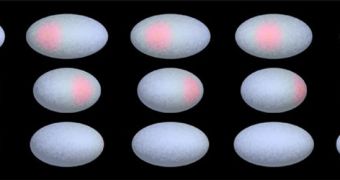Under the new International Astronomical Union (IAU) classification, Pluto and the other larger celestial bodies circling the Sun behind it are dwarf planets. Ceres, Eris, Haumea, and Makemake are all considered to be too small to fit the new planetary category. One of the most peculiar such objects is Haumea, a body that was accepted as a dwarf planet in September 2008, and that has a few peculiar properties, such as an ellipsoid form, with its greatest axis twice as long as its shortest one. Recent models have also proven that a dark, red spot also 'adorns' the surface of the dwarf planet, Space reports.
Other than Ceres – which resides in the inner asteroid belt – and Pluto, all the other three planets have not been resolved directly, but inferred through mathematical calculations. It is through such methods that Haumea was determined to be an ellipsoid. Further research has established that the object has enough gravity to bring it into hydrostatic equilibrium. This means that a pressure gradient on it creates a pressure gradient force, which opposes gravity with an equal force, thus creating a balance.
Recently, scientists analyzing the dwarf planet's light curve – variations in its brightness – determined that a dark, red pot must exist on its surface. “The two brightness maxima and the two minima of the light curve are not exactly equal, as would be expected from a uniform surface. This indicates the presence of a dark spot on the otherwise bright surface,” Queen's University Belfast astronomer Pedro Lacerda, from the United Kingdom, explains. Haumea also has a very weird rotational speed, in that one of its days is equivalent to 3.9 hours on Earth. It's still unknown what causes it to spin this fast.
“Our very first measurements of Haumea already told us there was a spot on the surface, but it was only when we got the infrared data that we were able to begin to understand what the spot might be,” Lacerda adds. According to some, it may be that the spot is made up of high concentrations of organic compounds, or minerals. Others believe that crystalline ice can be found at that location in higher fractions. “[...] We will get detailed spectroscopy of the spot to hopefully identify its chemical composition and solve the puzzle of its origin,” the expert concludes, taking about the scheduled observations of Haumea, which are to be taken in early 2010, using the European Southern Observatory's (ESO) Very Large Telescope (VLT).

 14 DAY TRIAL //
14 DAY TRIAL //